Vanderbilt Cup Race Historical Marker Unveiling Ceremony to be Held on Saturday, April 26, 2014
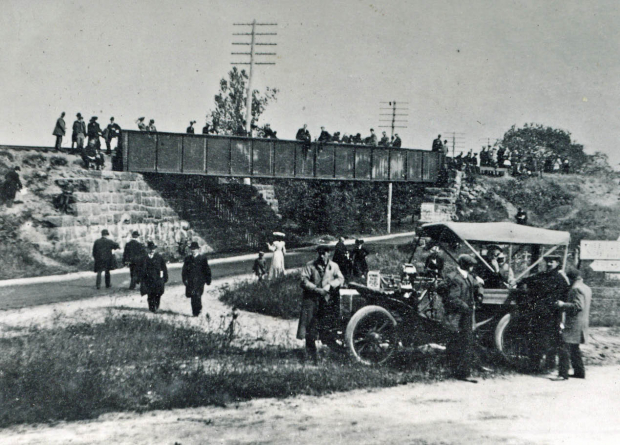
The Floral Park Historical Society has announced an unveiling ceremony for a Vanderbilt Cup Race Historical Marker on Saturday, April 26, 2014 from 12;00 pm to 2:30 pm.
Below is information reposted from the Floral Park Historical Society's The Docent Digest .
Enjoy,
Howard Kroplick
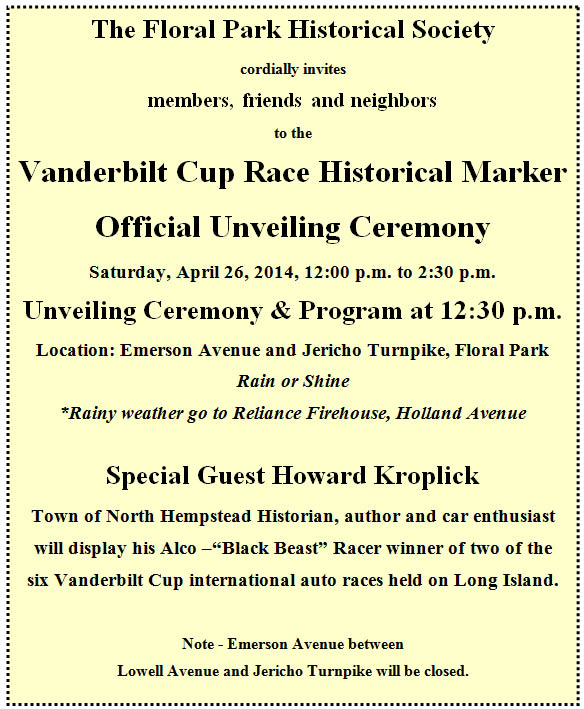
AARP Thank You For Your Generosity
The Floral Park Historical Society is a nonprofit organization that is grateful for the financial support of its membership and the community as well as the support of the Inc. Village of Floral Park and the services the various departments provide. The Vanderbilt Cup Historical Marker will highlight one of the most significant events in the community’s history. It is the third historic marker to be installed in Floral Park. The society installed the first one across from the Floral Park Library where John Lewis Childs house and seedhouse once stood and the Floral Park United Methodist Church installed the second one in front of the church on Verbena Avenue, the first church in Floral Park.
The casting of the marker takes several weeks. The cost is about $1,200. The society extends a special thank you to the members of the AARP of Floral Park for generously donating $200 toward the historical marker project. The AARP contributes funds to so many local organizations. We are pleased to have the AARP’s support of our mission and to have the financial support of this project. When people read the marker, many will learn about an aspect of Floral Park history that they will find surprising. Floral Park had a dirt road that welcomed the first international auto race. But it’s a fact, Jericho Turnpike, a dirt road that ran through Floral Park, was the route for the first international road race in the U.S.A.
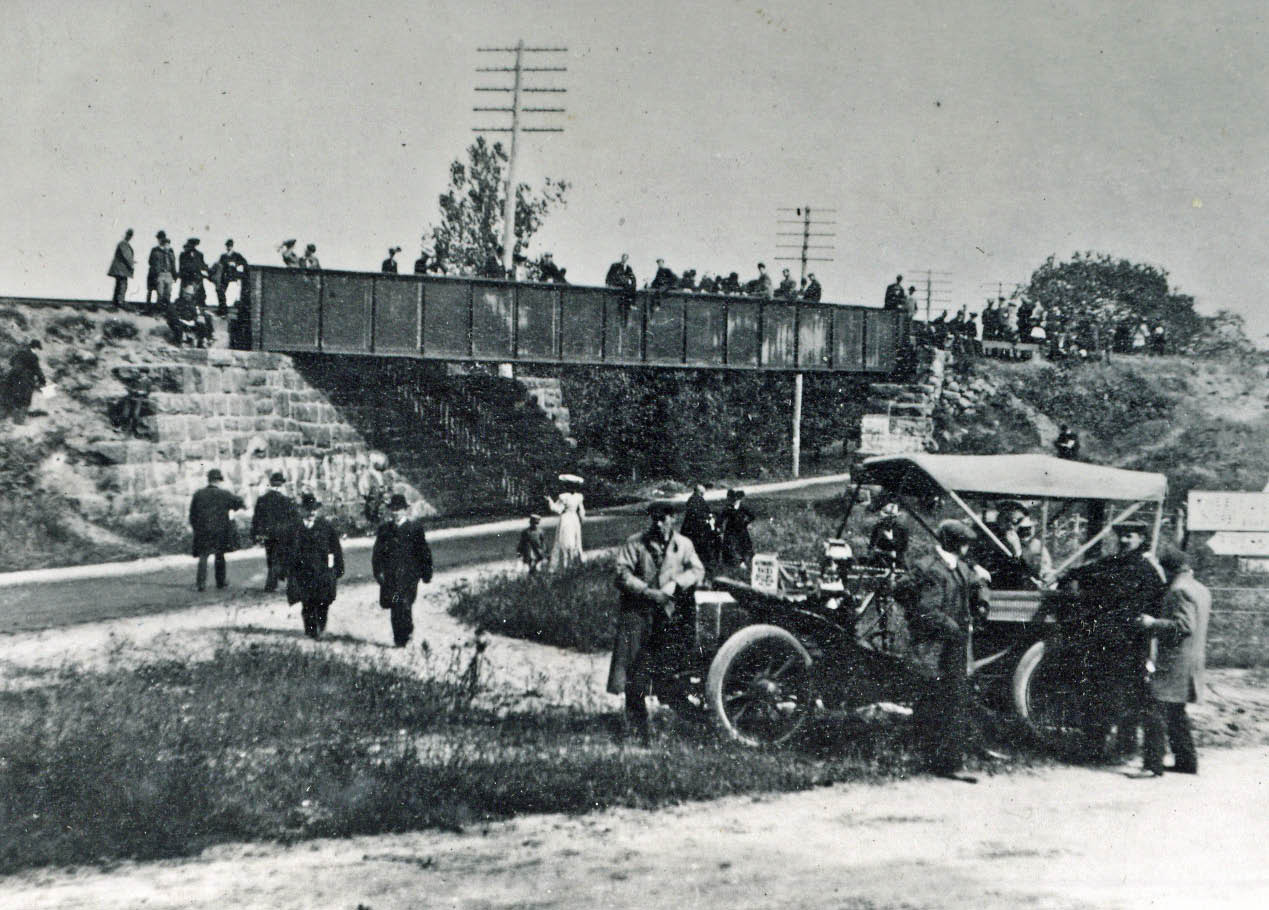
Vanderbilt Cup Race –Floral Park - October 8, 1904
According to Floral Park Village Historian Walter Gosden, “This photo of the Vanderbilt Cup Race was taken on October 8, 1904 in Floral Park.The photographer was facing east, the road is Jericho Turnpike. Tulip Avenue comes in from the lower right, Little Neck Parkway is to the left.
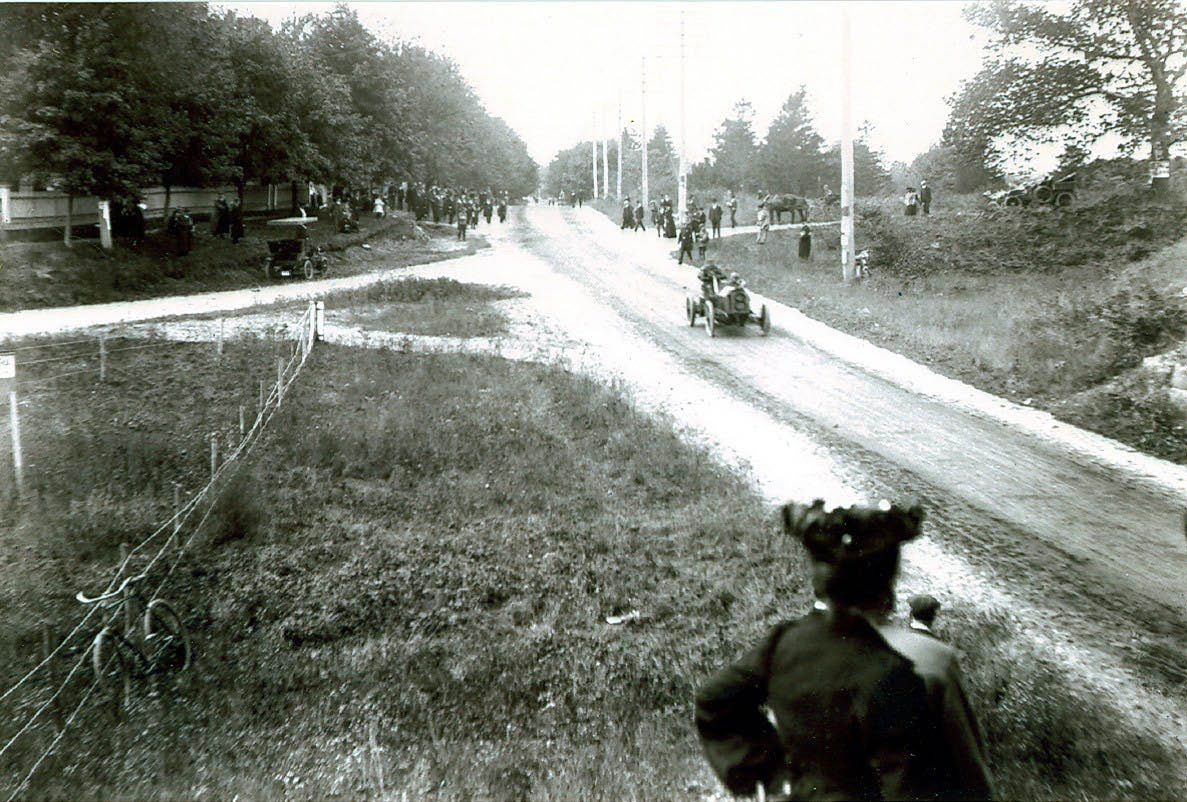
Spectators stood along the side of the road and watched the cars go by! When they got tired of waiting someone would walk out into the center of the road to look and yell "car coming" when one did. Pretty dangerous stuff considering the cars had very narrow tires and 2-wheel brakes so stopping over 30 mph was "push and pray."
History Note: The bridge pictured was enlarged twice before the final version was removed in 1975. The previous version was probably removed in 1960-61 time period, when Jericho Turnpike was widened. (Photo from Floral Park archives).
The Vanderbilt Cup Races
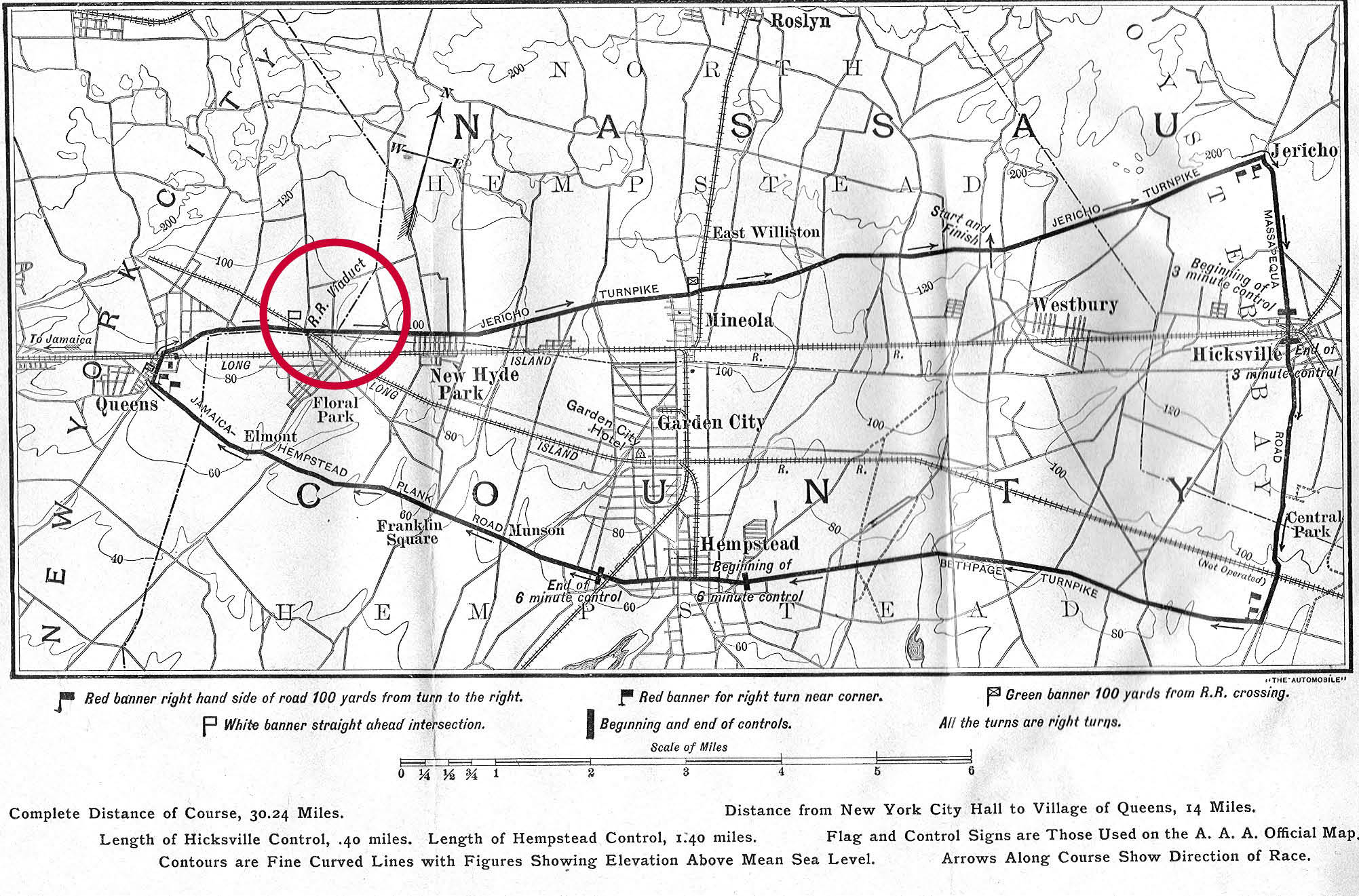
The first of six Vanderbilt Cup Races traversed Floral Park on October 8, 1904. The route followed Jericho Turnpike. It was the first international automobile race held in the United States. Long Island hosted the six Vanderbilt Cup Races held from 1904 and 1910.
William Kissam Vanderbilt II, age 26, was heir to a transportation fortune and a prominent figure in auto racing for nearly 10 years. Vanderbilt, who had sponsored auto races as a teenager, announced in 1904 his plans for the first international auto race to take place on Long Island, New York. The plan drew controversy over the use of public roads for auto racing. Thousands of free-spending visitors were expected to come to Long Island community to see the races. The fact that this would be an economic boon proved incentive enough for Nassau County supervisors to approve the use of public roads for auto racing. Area farmers who relied on horses for transportation and saw automobiles as playthings of the idle rich disagreed with the idea. Legal actions and hearings held by politicians failed to stop the race. Nassau County supervisors and judges gave their approval a few days before the Saturday race date.
Vanderbilt, “Willie K,” as friends called him, put up a large cash prize to encourage auto racing, a sport that in Europe spurred factory improvements to motor vehicle technology. The inaugural Long Island race Saturday, October 8, 1904 featured 17 vehicles and competition between European and American drivers. George Heath won the race in a Panhard, a French vehicle. The race ran over a 30.24 miles (48.7 km) course of dirt roads through Nassau County and the community of Floral Park.
An estimated 25,000 to 50,000 spectators lined the entire course. Vanderbilt, joined by the leaders of the automotive industry, gathered in a cluster of over 2,500 people in and around a wood plank grandstand at the Westbury start-finish line on Jericho Turnpike.
Right from the start the Vanderbilt Cup Races drew huge crowds of people who created serious crowd control problems. Vanderbilt devised a way to solve the safety issue as well as improve attendance at races. He formed a company to build the Long Island Motor Parkway, one of the country's first modern paved parkways that could not only be used for the race but would open up Long Island for easy access and economic development. Construction of the multi-million dollar toll highway began in 1907, to run from the Kissena Corridor in Queens County over numerous bridges and overpasses to Lake Ronkonkoma, a distance of 48 miles (77 km).
The 1908 race was held over parts of the new highway and much to the delight of the large crowd on hand, 23 year-old local hero George Robertson from Garden City, New York became the first American to win the event driving the American "Locomobile."
The Vanderbilt Cup races were held successfully on Long Island until 1910 In 1936 William Kissam Vanderbilt II's nephew, George Washington Vanderbilt III brought the race back to Long Island by sponsoring a 300-mile (480 km) race at the new facilities at Roosevelt Raceway. Once again, the Europeans were enticed by the substantial prize money and Scuderia Ferrari entered three Alfa Romeo racers. A lack of American competition and a less-than-exciting course layout saw the race run for only two years, both won by Europeans.
The Vanderbilt Cup would not return to the United States motor racing scene for more than twenty years. In 1960, sponsored by Cornelius Vanderbilt IV, it was run as a Formula Junior event and held again at Roosevelt Raceway. In 1965, 1967, and 1968, the Bridgehampton Sports Car Races were billed as the Vanderbilt Cup.
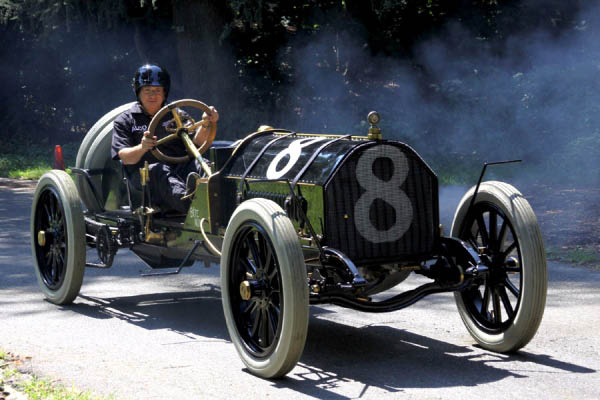
No, it isn’t “Willie K” at the wheel of this racer pictured above. Howard Kroplick, Vanderbilt Cup authority is driving his Alco – Black Beast, the racer won two of the Vanderbilt Cup Races held on Long Island.
What did John Lewis Childs think of Auto Races?
The following is an excerpt from an article that appeared in the Hempstead Sentinel, August 2, 1906 issue. It conveys the founder of Floral Park John Lewis Childs’ favorable opinion of the Vanderbilt Cup Races being routed on “macadam roads.”
Hempstead Sentinel, August 2, 1906
Hon. John Lewis Childs had a mighty interesting letter in Saturday's Brooklyn Times. It related to Long Island's advantages and the future which should make men think and act accordingly.
Nothing has so brought Nassau County to the front and made its merits known as its splendid macadam road system. In this, automobiles have played a most important part. The Vanderbilt cup races have advertised the county as nothing else could possibly have done. They have attracted to the Island many very wealthy people, and the residents of Nassau County cannot put their highways to a more stable use than to set a portion of apart for half a day once a year for these races.—Hon. John Lewis Childs, in Brooklyn Times.



Comments
This is going to be a very memorable and historic day for a lot of people, something not to missed
Walter, thanks for contributing your personal knowledge of the earliest era of the history of LI motor sports. Remember The Bridge (the last gasp?) Guy
Hi Guy, yes I remember the railroad bridge very well. When the last one was torn down a teenager 2 blocks from my house got a small piece of it that was cut off and had a rivet in it. This was later donated to the Historical Society, and is on display in their small museum.
Hi Howard,
Rather late reaction, but I had forgotten about it and came across it today. The car on the upper photo is a 1904 Matheson. Was this a reconaissance trip? The next year Matheson would compete with a car (unsuccessfully though) in the trials for the Vanderbilt Cup.
Wish you good weather on the day of the ceremony!
Regards and thanks for all of your work to keep the spirit alive!
Ariejan